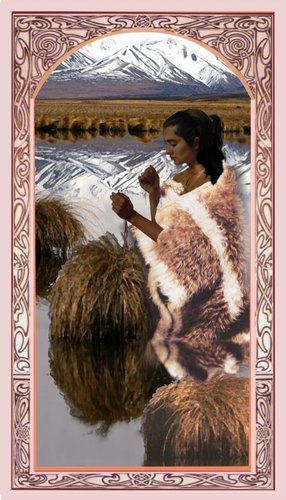Andrew Paul Wood – 24 July, 2011
In terms of contemporary New Zealand art, Eau Revoir has affinities with the paintings of Liz Maw and the less overcooked ethno-kitschy elements of Lisa Reihana's Digital Marae. It is the clever mingling and subtle blending of various sources in Eau Revoir that prevents the whole project descending into earnest kitsch - there is a classically tutored intelligence at work.
It is not often that one enters a provincial gallery and is actually struck (albeit briefly) by a local artist, but Claire Earlie Maxwell’s exhibition Eau Revoir at the Aigantighe Art Gallery in Timaru did just that to me. Maxwell was born in County Limerick, Ireland and trained at both the Limerick School of Art and the Dublin Metropolitan School of Art. She immigrated to New Zealand in 1981, and after gaining a teaching diploma from the Wellington College of Education and a BA in art history from Victoria University, she settled in South Canterbury in 1998. New Zealand’s art media spends insufficient time looking at what is going on in the smaller centres (other than New Plymouth of course) - Timaru, Oamaru, Ashburton, and Tauranga all have art galleries with exhibition programmes not to be sneezed at.
As the punning title alludes to, the exhibition is part of a growing body of political art protesting the polluting and diverting of the South Island’s East Coast rivers. In this case, each of the large unstretched canvases depicts a syncretic goddess representing a different river: Hakatere, Kakanui, Opihi, Orari, Pareora, Rakaia, Rangitata, Temuka, and Waitaki.
Maxwell begins with watercolour and collage, which is then re-imaged as a digitally manipulated print and finally touched up and added to by hand. Each somewhat Amazonian/Boadicean goddess is essentially a portrait - Aigantighe director Dr Fiona Ciaran, Marilyn Monroe, the artist herself (Orari as a sort of warrior-queen Maeve) - in a style primarily inspired by Maxwell’s Celtic heritage and the Art Nouveau posters of the Belle Epoque. A strong influence is Alphonse Mucha (1860-1939), a Czech poster artist working in Paris in the 1890s (the series was partly inspired by a Mucha poster the artist saw in Oamaru), and to a lesser extent artists like Steinlen and de Feure in France, Livemont in Belgium, Hohenstein and Metlicovitz in Italy, Toorop and Van Caspel in Holland, and Beardsley and the Beggarstaff Brothers in England. Perhaps there is a faint suggestion of Toulouse-Lautrec as well.
Art historical references abound in these works, mostly grounded in the late nineteenth century: the Symbolists, the PreRaphaelite Brotherhood, and the decadence of the fin-de-siècle. Predominantly the tutelary water divinities are garbed after Gustav Klimt (1862-1918), although here one might note an emerald taffeta off the shoulder from Dante Gabriel Rossetti’s Astarte Syrica (Manchester City Art Gallery, 1877), or a pose lifted wholesale from John William Waterhouse’s Circe Invidiosa (Art Gallery of South Australia, Adelaide, 1892).
In terms of contemporary New Zealand art, Eau Revoir has affinities with the paintings of Liz Maw and the less overcooked ethno-kitschy elements of Lisa Reihana’s Digital Marae. It is the clever mingling and subtle blending of various sources in Eau Revoir that prevents the whole project descending into earnest kitsch - there is a classically tutored intelligence at work. Maxwell doesn’t fall into the trap all too common among immigrant artists of loading up their decorative or allegorical work with a pastiche of seductive Maori imagery they are not entitled to. Sensibly Maxwell subtly brings in some Maori motifs (at least that is how I read certain koru-like forms), just enough to signpost place, translated through Art Nouveau.
If I was to be churlish enough to make criticism, it would be that the occasionally prints look a little over-Photoshopped and under-finished in places, and could stand to be even larger - perhaps over life-size. The resulting body of work, however, is most effective, even stunning with their highly-keyed palette, dramatic poses, charged atmosphere and elaborate whiplash hothouse borders. As the artist herself notes “Pretty much everyone looks at a beautiful woman”, but this is very much a celebration of strength and femininity, not just an attempt at eye candy.
In the centre of the exhibition space is a table laid with a diversity of old and decorative pitcher-and-tumbler sets, each containing water from one of the aforementioned rivers. These allude to a kind of trial by ordeal. The artist statement suggests, “Go out to the river and drink the water if you dare!” Ironically, a notice on the table warns that the water in the jugs is not suitable for human consumption. Take heed. Save the rivers.
Andrew Paul Wood


 Advertising in this column
Advertising in this column Two Rooms presents a program of residencies and projects
Two Rooms presents a program of residencies and projects



This Discussion has 0 comments.
Comment
Participate
Register to Participate.
Sign in
Sign in to an existing account.